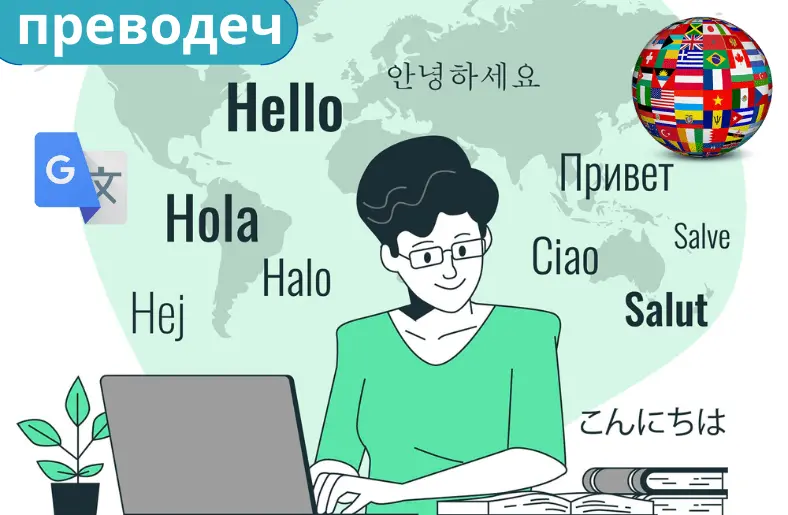Introduction:
In the digital age, language barriers often hinder communication and collaboration. However, with the emergence of technologies like преводеч, these barriers are gradually fading away. In this comprehensive guide, we delve into the world Potential of преводеч, exploring its various aspects, applications, and benefits.
Understanding преводеч:
преводеч, often referred to as translation, is the process of converting text or speech from one language into another while retaining its meaning. This intricate process involves linguistic expertise, cultural understanding, and advanced technology.
The Importance of преводеч:
преводеч plays a crucial role in bridging communication gaps in a globalized world. Whether it’s facilitating international business transactions, enabling cross-cultural exchange, or ensuring access to information, Potential of преводеч serves as a vital tool for connecting people and ideas across linguistic boundaries.
Applications Potential of преводеч
Business Expansion: With businesses increasingly operating on a global scale, преводеч facilitates communication with international clients, partners, and stakeholders.
Content Localization: In the realm of marketing and content creation, преводеч helps tailor messages to specific cultural contexts, ensuring relevance and resonance with diverse audiences.
Language Learning: преводеч aids language learners by providing access to a wide range of educational materials and resources in multiple languages.
Legal and Medical Fields: In sectors like law and healthcare, accurate преводеч is essential for ensuring compliance, patient care, and effective communication with clients or patients from diverse linguistic backgrounds.
Advantages of преводеч
Enhanced Communication: преводеч facilitates seamless communication between individuals and organizations irrespective of language differences.
Cultural Exchange: By enabling the exchange of ideas and perspectives across cultures, преводеч promotes cultural understanding and appreciation.
Global Reach: With преводеч, businesses can expand their reach to international markets, tapping into new opportunities and audiences.
Efficiency and Accuracy: Advanced преводеч technologies enhance efficiency and accuracy, reducing the time and effort required for translation tasks.
Challenges and Considerations
While преводеч offers numerous benefits, it also presents certain challenges and considerations. Factors such as linguistic nuances, cultural sensitivity, and the limitations of automated translation tools underscore the importance of human expertise in the преводеч process.
Exploring the Future of преводеч
As technology continues to advance, the future of преводеч holds immense promise and potential. With ongoing developments in artificial intelligence, machine learning, and natural language processing, we can expect to see further improvements in translation accuracy, efficiency, and scalability.
Advancements in Neural Machine Translation:
One of the most notable trends in преводеч is the emergence of neural machine translation (NMT) models. This approach allows for more contextually relevant and linguistically accurate translations, particularly for languages with complex grammar and syntax.
Integration of AI and Automation
AI-powered translation platforms are revolutionizing the way we approach the Potential of преводеч. These platforms utilize advanced algorithms to analyze and interpret text, identify linguistic patterns, and generate translations in real time. By automating repetitive tasks and streamlining the translation process, AI-driven solutions enable faster turnaround times, lower costs, and increased scalability.
Specialized Translation Services
As industries become increasingly specialized, there is a growing demand for tailored преводеч solutions that cater to specific domains and sectors. Whether it’s legal, medical, technical, or creative translation, specialized service providers offer expertise in niche fields, ensuring accuracy, consistency, and compliance with industry standards and regulations.
Enhanced Multimodal Translation
With the proliferation of multimedia content, there is a rising need for преводеч solutions that can handle diverse formats such as audio, video, images, and text. Multimodal translation systems integrate multiple modalities and data sources, enabling seamless translation across various media types while preserving context, tone, and intent.
Ethical and Cultural Considerations
As we embrace the benefits of преводеч technology, it’s essential to remain mindful of ethical and cultural considerations. Language is deeply intertwined with identity, culture, and expression, and mistranslations or misinterpretations can have profound implications. Therefore, it’s crucial to prioritize cultural sensitivity, linguistic diversity, and human oversight in the преводеч process to avoid unintended consequences and promote mutual understanding and respect.
Embracing the Evolution of преводеч
As the world becomes increasingly interconnected, the role of the potential of преводеч in facilitating communication and fostering global dialogue cannot be overstated. From breaking down language barriers to enabling cross-cultural exchange, преводеч continues to evolve in response to changing needs and advancements in technology.
Adapting to Technological Innovations:
In the digital era, technological innovations have revolutionized the field of преводеч, empowering translators with powerful tools and resources to enhance their efficiency and accuracy. From machine translation algorithms to computer-assisted translation (CAT) tools, translators now have access to a wide array of technologies that streamline the translation process and improve overall quality.
Harnessing the Power of Big Data
Big data analytics has emerged as a game-changer in Potential of преводеч, providing valuable insights into language usage, preferences, and trends. By analyzing vast amounts of textual data, translation professionals can identify patterns, common errors, and linguistic nuances, enabling them to deliver more precise and contextually relevant translations.
Expanding Language Access
In today’s interconnected world, the demand for преводеч extends beyond traditional languages to include dialects, regional variations, and minority languages. Translation technologies are constantly evolving to address this need, with specialized tools and platforms catering to a diverse range of linguistic communities and cultural contexts.
Empowering Human Translators
While technology has undoubtedly transformed the field of преводеч, human translators remain indispensable. Their expertise, cultural fluency, and nuanced understanding of language nuances ensure that translations are accurate, contextually appropriate, and culturally sensitive. As such, the future of преводеч lies in harnessing the complementary strengths of human translators and machine intelligence to deliver high-quality translations that meet the evolving needs of global audiences.
Promoting Linguistic Diversity and Inclusion

In an increasingly globalized world, linguistic diversity and inclusion are more important than ever. преводеч plays a crucial role in preserving and promoting minority languages, indigenous dialects, and marginalized voices, ensuring that all individuals have equal access to information and opportunities, regardless of their linguistic background. Embracing the Evolution of преводеч
As the world becomes increasingly interconnected, the role of the Potential of преводеч in facilitating communication.
History of преводеч
Origin and Development
The roots of преводеч can be traced back to ancient civilizations where rudimentary translation methods were employed. However, significant advancements in machine learning and artificial intelligence have propelled преводеч into the modern era, revolutionizing the way we communicate globally.
Types of преводеч
Machine преводеч
It is fast, cost-effective, and widely used for various applications.
Human преводеч
Human преводеч involves professional translators or linguists who manually translate content, ensuring accuracy and preserving nuances that may be lost in automated translations. While slower and more expensive, human преводеч is indispensable for complex texts and specialized fields.
Applications of преводеч:
Business
преводеч is extensively used in the business sector for translating documents, contracts, emails, and websites to facilitate international trade, collaboration, and expansion into new markets.
Education
In the field of education, преводеч aids language learners by providing instant translations of texts, lectures, and educational materials, fostering cross-cultural understanding and knowledge exchange.
Travel
For travelers, преводеч apps and devices offer real-time translation services, helping them navigate foreign countries, communicate with locals, and immerse themselves in new cultures effortlessly.
Challenges in преводеч
Accuracy
Despite technological advancements, ensuring the accuracy of the Potential of преводеч remains a significant challenge, especially for complex languages and specialized terminology.
Context
преводеч often struggles to accurately convey the context and nuances of language, leading to misunderstandings or misinterpretations, particularly in literary or cultural texts.
Cultural Nuances
Translating idioms, cultural references, and humor poses challenges for преводеч as these elements are deeply rooted in specific cultural contexts and may not have direct equivalents in other languages.
Benefits of Potential of преводеч
Time-Saving
преводеч significantly reduces the time required for translation tasks, enabling businesses to streamline their operations, accelerate project timelines, and reach global audiences faster.
Cost-Effective
Compared to traditional translation services, Potential of преводеч offers a more cost-effective solution, particularly for large volumes of content, allowing businesses to allocate resources more efficiently.
Accessibility
преводеч enhances accessibility by breaking down language barriers, making information and resources available to individuals who may otherwise struggle to access them due to linguistic differences.
Future of преводеч
Advancements
Continued advancements in artificial intelligence and machine learning are poised to further enhance the capabilities of преводеч, enabling more accurate, natural-sounding translations across a wide range of languages and contexts.
Integration with AI
The integration of преводеч with AI technologies such as natural language processing and speech recognition holds immense potential for creating more sophisticated translation systems capable of understanding and generating human-like translations.
How to Choose a преводеч Service
Accuracy
When selecting a преводеч service, prioritize accuracy by choosing providers with advanced algorithms and quality assurance measures to ensure reliable translations.
Languages Supported
Consider the languages supported by the преводеч service to ensure compatibility with your target audience and linguistic requirements.
Reviews and Reputation
Research the reputation and customer reviews of the Potential of преводеч services to gauge their reliability, quality of translations, and customer satisfaction levels.
Best Practices for преводеч
Clear Communication
Provide clear and concise source material for преводеч to work with, avoiding ambiguities and complexities that may hinder accurate translations.
Proofreading
Always proofread преводеч translations to identify and correct any errors or inconsistencies, ensuring the final output meets quality standards.
Using Context Clues
Utilize context clues and additional context whenever possible to aid преводеч in producing more accurate and contextually relevant translations.
Common Myths About преводеч
Replacement for Human Translators
Despite advancements in преводеч technology, it is not intended to replace human translators entirely but rather complement their efforts, particularly in cases requiring cultural sensitivity and linguistic expertise.
Only for Written Text
Contrary to popular belief, преводеч is not limited to written text and encompasses a wide range of applications, including speech translation, real-time interpretation, and multimedia translation.
The potential of преводеч (FAQs)
Q: Is преводеч suitable for all languages?
преводеч applies to a wide range of languages, including both widely spoken and less common ones. However, the quality and accuracy of преводеч may vary depending on factors such as linguistic complexity and the availability of linguistic resources.
Q: How can I ensure the accuracy of преводеч?
To ensure the accuracy of преводеч, it’s essential to utilize reputable translation services, employ qualified translators, and conduct thorough quality assurance checks. Additionally, incorporating human review and feedback mechanisms can help identify and rectify any errors or inconsistencies.
Q: Are there any privacy concerns associated with преводеч?
Privacy concerns may arise when sensitive or confidential information is involved in the преводеч process. It’s crucial to choose trusted translation providers that prioritize data security and adhere to stringent privacy protocols to safeguard sensitive information.
Q: Can automated преводеч tools replace human translators entirely?
While automated преводеч tools offer convenience and efficiency, they may not always match the accuracy and nuance of human translation. Human translators bring cultural understanding, linguistic expertise, and contextual knowledge to the преводеч process, ensuring high-quality and culturally sensitive translations.
Q: How can I leverage преводеч for my business?
Businesses can leverage преводеч to expand their global presence, reach new markets, and engage with international customers and stakeholders. By investing in the professional Potential of преводеч services, businesses can enhance communication, foster cultural exchange, and drive growth and innovation.
Q: What are the emerging trends in the field of преводеч?
Emerging trends in преводеч include the integration of artificial intelligence and machine learning technologies, the rise of neural machine translation models, and the growing demand for specialized translation services in niche industries such as e-commerce, gaming, and healthcare.
Conclusion:
In conclusion, the Potential of преводеч is a powerful tool that transcends language barriers, enabling communication, collaboration, and cultural exchange on a global scale. By understanding its significance, applications, and benefits, individuals and organizations can harness the full potential of преводеч to connect with the world and unlock new opportunities for growth and innovation.









